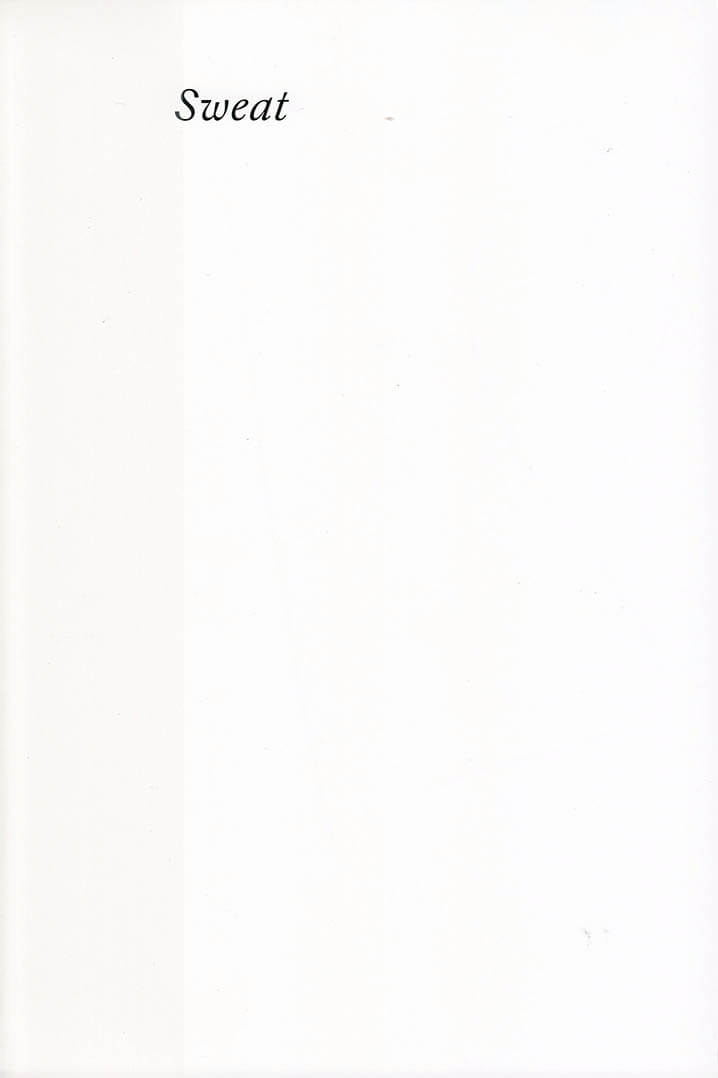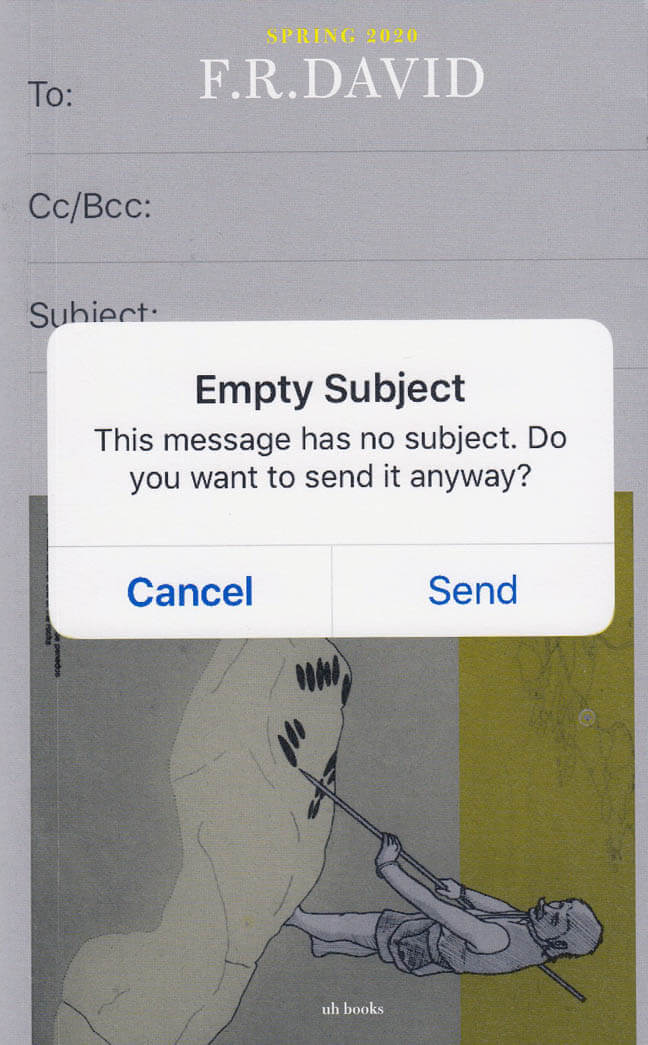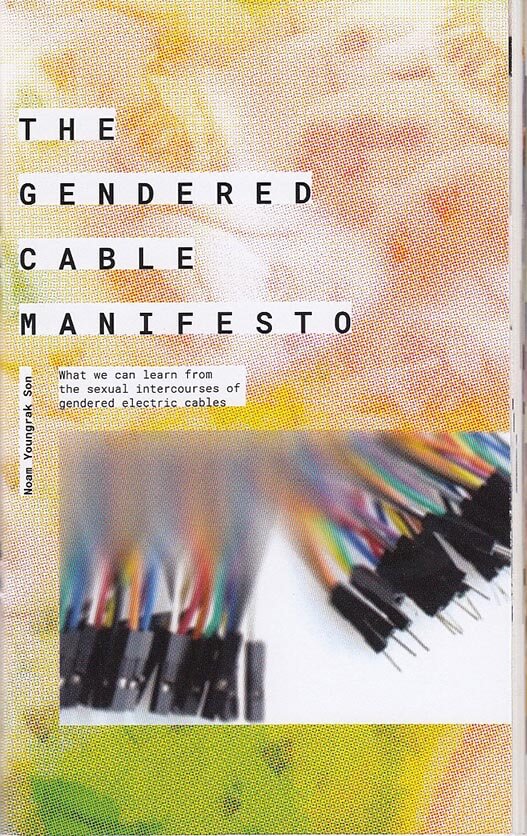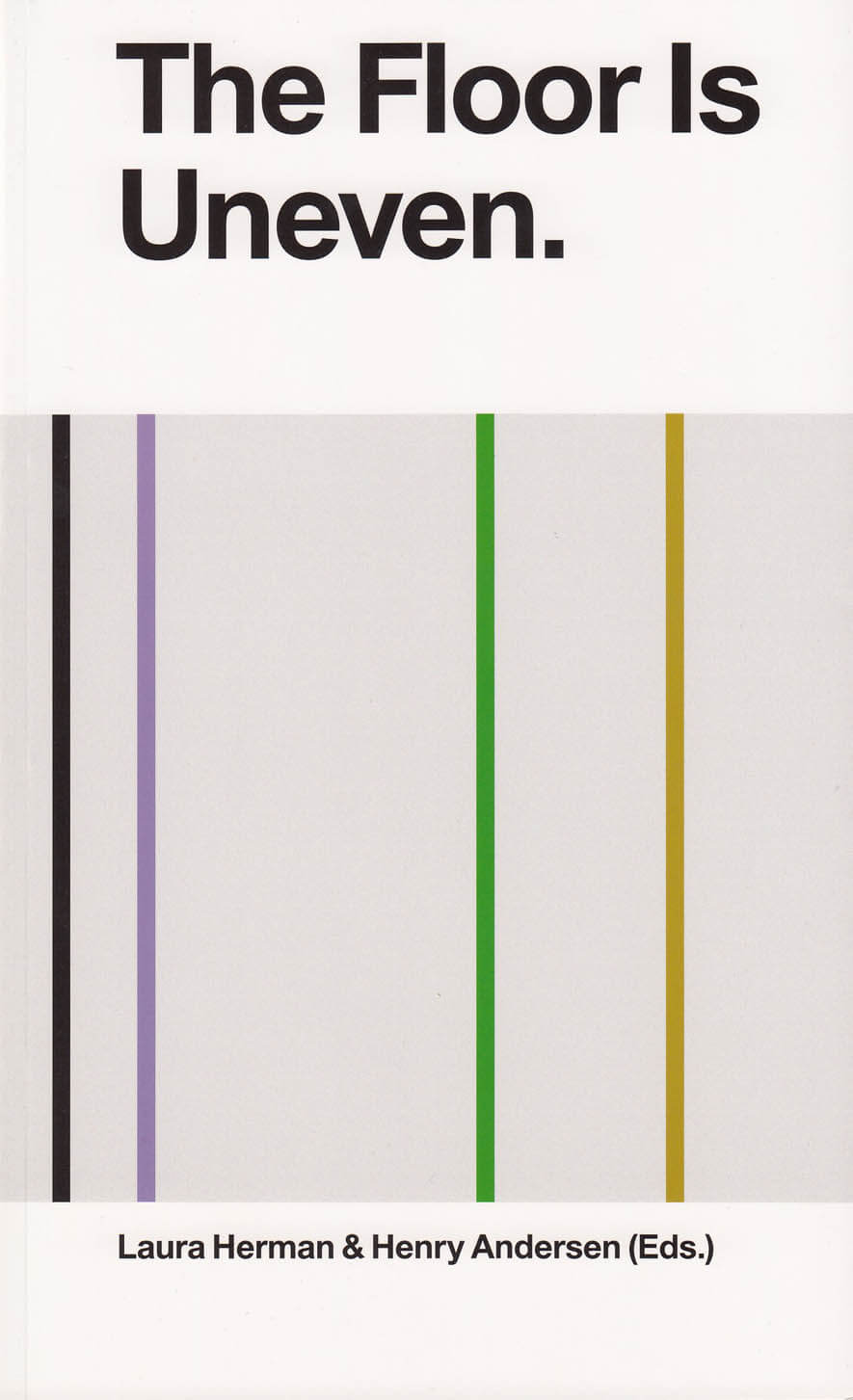Artists' Books
Artists' Books

This Is My Love, Nobody Can Choose It For Me
In her new book, Mina Fina continues to explore the themes of representation of the female body. Through her interventions to the images from old erotic magazines, she questions the normatives of body acceptance and places it into abstract compositions that are half drawings, half collages.

RISO PARADISO, 33 1/3
Riso Paradiso is a collective of six individuals connected by research and creation in the fields of risography, graphic design, printing techniques, visual communications, photography, illustration and publishing.
The book is continuation of a residency project that was held in January 2020 at the Hiša kulture Pivka gallery. Theme of the residency was inspired by the in-house LP collection of colleague Leon Zuodar who also co-runs the gallery. Through his record collection they recognised the spirit of their generation.
Result of the residency was 6 different screen prints, but the idea was further upgraded as the project proceeded and an art publication in the risography technique was conceived.

Sweat
‘Sweat’ brings together images of sweat forms taken by Alex Farrar and collated from Instagram, celebrity websites and photo libraries. Stock and staged imagery are displayed alongside paparazzi shots and documentary images. The suggestion of a figure builds accumulatively as we flick through the pages, our eyes grow accustomed to seeing a body that is never fully explicated. Why sweat?
Text by George Vasey
Hand numbered edition of 150

Vava Dudu
The first anthology of poetry by fashion designer, musician, painter, and Paris icon Vava Dudu. Vava’s poems are culled from language she prints and publishes on garments, as well as song lyrics from her electro-punk band La Chatte. Here her texts are translated from French to English by New York artist, musician and educator Geo Wyeth, and edited by Castilian writer and curator Alberto García del Castillo.
The book was completed in residency at the Centre for Fine Arts, Brussels (BOZAR), as part of the public program accompanying a retrospective exhibition of Keith Haring.
The edition comes in both blue and black prints.

Agatha Bauer
Maru Mushtrieva, Romy Kießling and 1 more
The title of publication series ‘Agathe Bauer’ stands for a broadly misheard hook “I’ve got the power” from a German 1990 Eurodance hit ‘The Power’ by the band Snap! The hook that turned the song into a hit, came from Jocelyn Brown’s track ‘Love's Gonna Get You’, but neither her name nor the track appears in the credits. And, here is where Agathe Bauer comes in - a mysterious being who acquires agency through the homophonic misinterpretation of the main hook “I’ve got the power”.
In ‘Issue Zero: Picking Up Promises’ Agathe has an agenda. Nothing could be as it would have been, but she is here to trace the sources of how it has become. Agathe Bauer is here to analyze the capacity of misinterpretation to unveil asymmetric power structures in knowledge systems and by tuning into the social-political, cultural and aesthetic dimension of it.
‘Issue Zero: Picking Up Promises’ features contributions by: Gabriela Acha, [{“CIBELLE”(CAVALLI}BASTOS)], Lynn Hershman Leeson, Romy Kießling, Markues, Luzie Meyer, Maru Mushtrieva, Claudia Pagès, Ruth Wolf-Rehfeldt, Miriam Stoney, Christine Sun Kim, Eric Winkler, Miriam Yammad, Anna Zett.
Conceptualized and edited by Gabriela Acha, Romy Kießling, Maru Mushtrieva.
Designed by Timur Akhmetov.

F.R. David - Very Good
F.R.DAVID is a typographical journal, dealing with the organisation of reading and writing in contemporary art practises. The 19th issue, “very good*” is edited with Paul Abbott. Like music, the issue’s “theme” is better off unaccounted for, and up in the air, like a flock of birds (creatures who feature heavily), circling around performance, listening bodies, given time, and loving relations.
The nineteenth issue of ‘F.R.DAVID’ is edited by Will Holder and Paula Abbott, and will serve as a reader for “We can still see the horizon (and it’s curved)”, a summer residency in Scotland led by the editors. It includes a surprising array of contributions from writer Jorge Luis Borges, journalist and writer Italo Calvino, composer Hugo Cole, literary critic and theorist Barbara Herrnstein Smith, percussionist Milford Graves, philosopher Michel Serres, novelist and essayist Wilson Harris, poet Bernadette Mayer, composer and music theorist Harry Partch, pianist and poet Cecil Taylor, and several others.

Dedication(s)
‘To C.L.S.’, ‘For A.L.M.’, ‘In Memory of J.V.C.’ – Starting from his collection of three-letter dedications, Robin Waart’s new artist book "Dedication(s)" looks at public yet hidden modes of address. While these dedications appear in printed books, they remain private, intimate allusions between author and intended recipient. The project infers the strange position of the reader who encounters these cryptic dedications, which perhaps get in the way of—or better clarify?—the relationship between author and audience. Waart’s project questions the relationship between a work and the reality in which it comes about, and why, and for whom, we make what we make.
2018, book publication, offset and watermark on paper, edition of 800, 26 x 20.3 x 0.65 cm

March
March brings together poems and performance texts by Nathalie Rozanes, as well as a conversation with Elizabeth Ward and Tarek Halaby.
'Maybe I have never made a performance that was not about identification and its complexity. About positioning oneself. Maybe I have never made a piece that is not about how one thing leads to another. Maybe I have never made a piece that is not about process. (...)'
Published May 2020.

Beauty Kit
BEAUTY KIT – AN ECO-EROGENOUS ART PROJECT by Isabel Burr Raty with contributions by Kristin Rogghe, Elke Van Campenhout, Gosie Vervloessem, Pablo Diartinez and Tim Vets, is an experimental catalog summarizing Isabel Burr Raty’s research on conceptualizing and manufacturing eco-erogenous para-pharmaceutical products. It tells the story of the BKFF, a mobile farm where she and other females harvest their orgasmic juices to produce beauty bio-products, used for treatments in the BK Spa, critically discussed in the BK Focus Group and moving forward into becoming a village, where every-body harvests each other. The catalog comes with contributing text, “Harvesting bodies – The Farm as Paradox” by Elle/Elke Van Campenhout, and other reflections on the project.
Isabel Burr Raty is a Belgian-Chilean artist, filmmaker, and Media Art History teacher in ERG (École de Recherche Graphique), living between Brussels and Amsterdam. She is currently developing her second feature film, about the colonial impact on Easter Island, and creating live art and new media installations that queer production understandings, such as the Beauty Kit Project. Her works have been shown internationally.

O Fortuna
In 2015, Jacob finds himself wandering the streets, swamps and cemeteries of New Orleans. Through his search for a man named Ignatius, 'O Fortuna' tells the story of his attempt to make a film. We discover the city’s unique atmosphere and meet a bizarre cast of characters who assist Jacob with his uncertain attempts at shooting scenes of DAT LIKWID LAND.

Deux Soeurs
From Audre Lorde and Adrienne Rich to Basma Alsharif and Pauline Oliveros, Deux Soeurs brings together a chorus of voices that explore representations of parenthood, friendship, and disobedience.
The book acts as a reader to artist Beatrice Gibson's films, I Hope I'm Loud When I'm Dead (2018) and Two Sisters Who Are Not Sisters (2019), and includes material that informed Gibson's working process, together with the artist's texts and notes used in both films. Turning to the figure of the poet as a guide in times of chaos, Deux Soeurs presents a framework for an ethics of artistic and social collaboration.

Ferrara Deux (Faits Divers)
faits divers are the various reports in a news bulletin, miscellaneous human interest stories, theorised by Roland Barthes as ‘total’ and ‘immanent’ information.
ferrara deux (faits divers) scrolls around the discovered corpse of a talented street musician named Landau, mangled and sealed into vacuum bags in the walk-in of a modern Italian-American restaurant. Street performance is content for an attention economy, playing on authenticities and profiting from recognition.
In this debut novel, artist Ivan Cheng reconfigures recent performance texts into an approximation of a murder mystery.

Oslo National Academy of the Arts
Segunda Vez: How Masotta Was Repeated
Publication documenting the research made by Dora García for a video project on Oscar Masotta, pioneer of Lacanian psychoanalysis in Latin America and influential art critic.
It features a selection of Masotta's writings as well as contextual essays on his work.Segunda Vez is an art research project centered on the figure of Oscar Masotta (Buenos Aires, 1930, Barcelona, 1979), an author of groundbreaking texts about the Happening, art, and dematerialization, a pioneer of Lacanian psychoanalysis in the Spanish-speaking world, and a happenista. The project has yielded a full-length and four medium-length films by Dora García, two Cahiers documenting the research, and this book. Segunda Vez: How Masotta Was Repeated offers a selection of Masotta's writings, including his early study of Argentinean author Roberto Arlt, as well as texts that contextualize Masotta's thought and broaden the reach of his reflections on the intersections between performance and psychoanalysis, art and politics.
Edited by Emiliano Battista.
Texts by Dora García, Oscar Masotta, Roberto Bolaño, Jorge Jinkis, Inés Katzenstein, Ana Longoni, Emiliano Battista, Aaron Schuster, Julio Cortázar.
English edition
13,5 x 21 cm (hardcover)
320 pages (color & b/w ill.)

Apokolypse of the praktikal moment
Starship Magazine #19 presents contributions by John Boskovich, Elijah Burger, Simon Denny, Cornelia Herfurtner, Yuki Kimura, Vera Palme, Nora Schultz, Jack Smith; and by Rosa Aiello, Carter Frasier, María Galindo, Samuel Jeffery & Daniel Herleth, Elisa R. Linn, Paul B. Preciado, and Haytham El-Wardany
introducing new columnists: Mihaela Chiriac, Michèle Graf & Selina Grüter, Julia Jung, The Parliament of Bodies, and Ulla Rossek
and our columnists: Tenzing Barshee, Gerry Bibby, Mercedes Bunz, David Bussel, Eric D. Clark, Jay Chung, Hans-Christian Dany with Valérie Knoll, Francesca Drechsler, Stefanie Fezer & Vera Tollmann, Julian Göthe, Karl Holmqvist, Stephan Janitzky, Jakob Kolding, Lars Bang Larsen, Ariane Müller with Huang Rui, Robert M. Ochshorn, Mark von Schlegell, Max Schmidtlein, Amelie von Wulffen, and Florian Zeyfang
and artworks by Melvin Edwards, Elizabeth Ravn, Nong Shoahua, and Mark van Yetter.

Parrhesiades Vol. 1
Parrhesiades is a multi-platform project, established in 2019 by curator Lynton Talbot to work with artists for whom language, either written spoken or otherwise performed is an essential part of their practice. Together with the artist, parrhesiades develops a single new work that exists across multiple platforms. With contributions by Quinn Latimer, Sung Tieu, Jesper List Thomsen, Elaine Cameron-Weir, Johanna Hedva, Eva Gold and Cally Spooner.

Forms Of Life Of Forms
FORMS OF LIFE OF FORMS brings artistic research into form – not merely as an aesthetic question but as a social and political one. Indeed, there are no politics without form! With Forms of Life, Rob Ritzen curated several “Moments” that assembled works, collective readings, and other references into a single installation. This publication reshuffles documentation of these “Moments” as a visual reflection of the trajectory of this research.
Rob Ritzen works as a curator with a background in philosophy. His curatorial practice is focusing on self-organized and cooperative formats. Consciously positioned at the margins of established institutions and outside of market-oriented spaces, his practice is placed in close association with communities of cultural practitioners. His initiatives are attempts to reconfigure the politics of making art and alternative forms of production and presentation.

Beige Persuit
A character called X journeys through a present that is neither here nor there, but feels oddly proximate. She moves through landscapes of words, ever-shifting to host the groundless present, a place and time driven by her motivated, yet contextless pursuit. Narrative is always under construction. The preferred medium for X's peregrinations: a sentence, as capacious as a three-second video, a ten-year nap, or an unexplored hard drive. In this suspended world, X's sensorium is curious and alert, but also anguished, hesitant, and precarious: she feels around for sympathetic energies and familiar faces along the way. Along what way? A book like a body might be a room for waiting, a machine for memory, a sensuous thing, an image quickly glimpsed...
Working across a range of media including video, sound, performance, sculpture, collage, and installation, New York-based artist Sara Magenheimer disrupts, manipulates, and defamiliarizes language with bold combinations of image and text. Her videos incorporate traditional filmic editing techniques alongside those inspired by music and collage.

The Gendered Cable Manifesto
"Gender as a concept is not only applicable to humans. When the idea of gender is applied to the cables, its meaning is reduced into a relationship of insertion. As a non-binary individual and designer, I find this problematic that such way of classifying gender violently erases the existence of everyone that doesn’t neatly fit into those categories. However, instead of insisting on abolishing those terms, I discovered that the idea of gender that we applied to the electric cables functioning in very queer ways that we couldn’t expect." More on www.d-act.org.

Return To Leptis Magna
Anna Barham’s Return To Leptis Magna is a book which compiles anagrams of the title sentence. We designed the rules which allowed the artist to compose the book, including a typeface which has different letterforms for characters that appear more than once, so that each letter is unique.
Design by Anna Barham & Julia. Typeset in Leptis, designed by Julia.

Poisonous Oysters
The material in Poisonous Oysters was generated during a live production reading group held in Newcastle University’s Fine Art Department on 26.01.18. Passages from the texts listed below were read aloud by the participants and interpreted by speech recognition software over and over, creating a poly-vocal feedback loop with the machine. The output is rewritten here as a score, flattening the time of the event and aligning the different versions of the texts to reveal the sound mutations between them.
Precarious Life, Judith Butler
The Waves, Virginia Woolf
Vampyroteuthis Infernalis, Vilém Flusser
Body Pressure, Bruce Nauman
Testo Junkie, Beatriz Preciado
The Politics of Translation, Gayatri Spivak
Creating trance and hypnosis scripts, Gemma Bailey
Untitled document, John Latham

Under Current
Companion reader for Under Current, an exhibition and film by Alice dos Reis. With 'Blue Carbon' by Holly Childs, 'Hydrofeminism: Or, On Becoming a Body of Water' by Astrida Neimanis, 'King Tide' by Sophia Al-Maria, 'Notes on a Dotted Red Wave' by Danea Io, 'Smart Oceans, Alien Times: Octopi Engineering' by Bogna M. Konior, 'To a Current's Ear' by Alice dos Reis and more. Bilingual edition (Spanish-English).

the project
the project - a project about love and intimacy. 'It is a method that touches on (or rather, crashes into) some (artistic) ‘taboo’s’, surrounding the ways in which the autobiographical, one’s intimate life and those who partake in that, can and ought to be dealt with within one’s artistic work. She ‘gets away with it’ and I think the reason for that is that she doesn’t try to spare herself or seek a safety zone, nor does she shun her artistic, author’s responsibility: she is constantly both in the middle of the sticky hot soup in which she is cooking her research and she doing the stirring, the spicing and the serving.' - Philippine Hoegen

The Floor Is Uneven. Does It Slope?
In 1987, artist and poet Madeline Gins (1941–2014) and her partner, painter Arakawa (1936–2010), formed the Architectural Body Research Foundation (later to become the Reversible Destiny Foundation)—an architectural office pursuing the radical conviction that architecture would provide humanity with the necessary tools and training to overcome death. Their wide variety of theories investigated how a person might interact with their environment, and how that environment might condition and enhance the body to increase its capabilities—through a constant undoing and unsettling of subject formation. Taking the work and writings of Madeline Gins and Arakawa as a broad provocation, The Floor Is Uneven. Does It Slope? aims to swallow and masticate the duo’s thought into a new sort of pulp: a collective fan fiction work. Less a book about Gins and Arakawa than a book after them, it tries to seed their work to various fans—writers and makers indebted to the duo’s thinking or suspected to be enthralled by it.
Contributors speak about Gins and Arakawa through the language of their own practice, through academia, poetry, essays, photography, experimental writing, and fiction—thinking about what Gins and Arakawa might mean to their individual fields.
Texts by Henry Andersen, Lila Athanasiadou, Ben Thorp Brown, Lucas Crawford, Bryana Fritz, Laura Herman, Daisuke Kosugi, Joyelle McSweeney, Simone C. Niquille, Andros Zins-Browne.

Vagabondi Efficaci
The words collected in the book form a constellation of texts in which the theme of walking becomes a mode of being, a poetic disposition, to redefine one’s relationship with space-time. With words by Kathy E. Ferguson, Emily Dickinson, Sylvia Plath, Carlo Ginzburg, Fernand Deligny, John Ruskin, Susan Leigh Star & Geoffrey C. Bowke, Usrula K. Le Guin, Arthur Rimbaud, Jack Eliott Cardno, Costanza Candeloro, Axelle Stiefel, Giulia Essyad, Gianmaria Andreetta, Arnaud Wohlhauser.